
Color and grain patterns are the primary factors influencing the appearance of wood. Other characteristics such as stains, burls, and insect damage also have an effect. All are variable, not only in different commercial groups of wood, but within a given species, log, or board. (This infinite natural variety is one of wood's greatest selling points).
The natural causes of color variation within a species are influenced by many factors. Soil types, minerals, water levels, available sunlight, temperature, and genetic composition, all contribute to color variation.
Hardwood trees regenerate from seeds, root sprouts, and stump sprouts. Trees originating from seeds contain genetic variables from two parent trees, while sprouts from roots and stumps will be genetically identical to the parent tree. Because of these variables, trees of the same species from one area may be quite different from that of other areas. The actual color variations are caused by natural chemical extractives found in the cell walls of wood. The hues produced through these deposits cover a wide range and are traceable to four spectral colors: red, orange, yellow, and violet. Other natural influences such as fungi may also contribute to some color variations. The range of color variation in a commercial lumber group may be increased by the mixing of species, such as northern red oak and pin oak within the red oak commercial group. Logs of these species are normally not separated by sawmills. This mixed lumber will increase the color variation in products manufactured from this material.
Grain variation, like color variation, is influenced by many factors. They include, but are not limited to, tree size, growth rate, climate changes, site conditions, genetics, bird, insect, and fire damage.
Effects of Growth Rings
The amount of annual growth influences the appearance of sawn lumber. Growth rings of a tree are distinctive because of the light and dark colors. The lighter portion is usually grown in the spring and is called "summer-wood." The size of the growth rings varies from species to species and even tree to tree depending on many factors including genetics and growing conditions. These two examples have approximately the same growth ring orientation yet look very different.
Narrow growth rings.
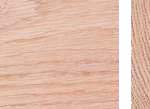
Wide growth rings.
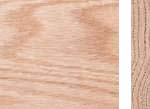
Burl Grain
Burl grain is common in most species and is also known as curly grain, burly grain, fiddle-back or figure wood. Various causes of burl grain include knot location, damage to the bark cambium layer, and tree genetics. Burl grain is often a desired characteristic for specialty products. Burl grain can be difficult to machine.
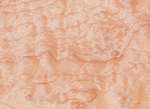
Tiger Stripe / Cross Fire
This unique grain pattern (called zebra-wood) is common in red and white oak and both hard and soft maple. This unique grain pattern can be found in other species as well. Tiger stripe is most often found along with burl grain, which can be difficult to machine or sand. Wood with this grain characteristic is often quite dense compared to the average density of the species.
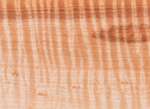
Bird's Eye
Bird's-Eye, as seen in this hard maple example, is a small area in the wood where fibers are contorted to form circular figures that resemble birds' eyes on the surface of the board. It is common in hard maple but rare in other species.
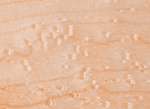
Knots
Knots vary in size, shape, structure, and color. Because of this, it may be the most difficult characteristic of wood to classify. Knots also account for large yield losses in our industry and cause us to buy Select and Better grades of lumber, as opposed to #2 Common grade, at a significant cost increase. Because of these factors, it is important to understand (as best we can) the knot variations.

Bird Peck
Bird peck is shown here in hickory. Woodpeckers produce a small hole, which is the starting point for brown to blackish mineral streak. This is also common in maple.
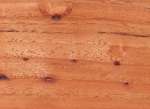
Cats Paw
Wood characteristic that has the shape of a cats paw caused by pin knots. This is most common in cherry.
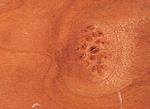
Pitch Pocket
Pitch pocket (sometimes referred to as gum spot) is common in cherry. It is caused mainly by peach bark beetles and cambium miners. The feeding insects cause injury to the living portion of the bark, leading to the formation of gum spots in the wood as the tree continues to grow.
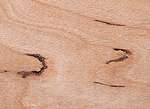
Worm Track
Worm track (also referred to as pith fleck) is shown here in hickory. Worm track appears as small, narrow, yellowish to brownish streaks 1/32" to 1/16" wide and 1/8" to 2" long. Worm track is caused by cambium miners feeding beneath the bark from the branches to the roots. Their tiny burrows are filled in by new cell growth and become embedded in the wood as the tree continues to grow.
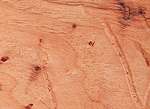
Worm Hole
The damage in this red oak example was caused by oak timber worms. These worms cause most worm hole damage seen in red and white oak. The worm tunnel size ranges from 1/64" to 3/16". Wood moisture content must be above 30 percent for timber worms to continue activity.
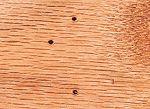
Incipient Rot
Rot (also known as decay) is the decomposition of a substance by fungi. This photo of red oak shows incipient rot, which is rot in the early stages, and is identified by a slight discoloration or bleaching of the wood. Rot-causing fungi grow only in wood with a moisture content above approximately 30 percent and cease growing when the wood is dried below 30 percent.
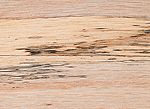
Ray Flecking
Ray flecking is visible in hardwood species that are quarter sawn and have rays. Rays are stripes of cells that extend radially within a tree. These rays primarily store food and transport it horizontally. Red oak and white oak are most noted for this characteristic. The examples show ray flecking with variations in ray widths.
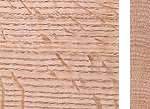
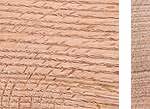
Bark
This example shows a piece of lumber with bark on its outer edge. The outer portion of the bark is the non-living portion which protects the inner living portion from external damage.

Bark Pocket
This example shows a typical bark pocket with a bark-filled hole on the board surface.

Mineral Streak
A darkened or discolored wood area, caused by minerals which the tree extracts from the soil, can be either mineral streak or mineral stain. Mineral streak appears as a blackish blue, well-defined streak running parallel with the grain. It is commonly found in maple and birch, and occasionally in oak and cherry. The streak can be measured easily by its length and width.
